Resource Center
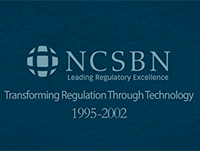
1995–2002: Transforming Regulation Through Technology
Emerging technologies were changing the world as the beginning of the 21st century approached. NCSBN welcomed new technological tools, resources and mediums that forever changed the trajectory of nursing regulation.
2018 | Video
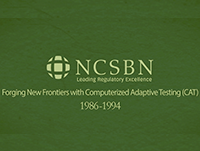
1986–1994: Forging New Frontiers with Computerized Adaptive Testing (CAT)
NCSBN had its eye on the future as it began researching the use of computer adaptive testing for the NCLEX. It took several years of research and hard work by dedicated professionals, but in 1994, NCSBN became the first health care organization to utilize computerized adaptive testing for the purpose of licensure.
2018 | Video
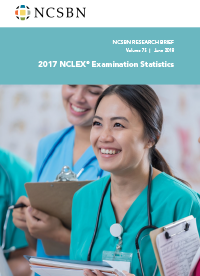
2017 NCLEX Examination Statistics
This annual publication provides national and state summary data of member boards’ licensure activities, as well as data on candidate performance on the NCLEX-RN and NCLEX-PN Examinations. On Jan. 5, 2015, the first candidates were able to take the NCLEX-RN for purposes of licensure/registration in Canada. This publication provides a detailed breakdown of candidate performance for 2017, as well as historical data.
2018 | Publications
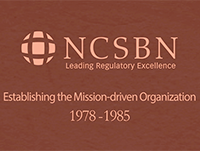
1978–1985: Establishing the Mission-driven Organization
The first several years of NCSBN's existence focused on establishing a mission-driven organization that was rooted in public protection and strengthening the role of nursing regulatory bodies in nursing regulation.
2018 | Video
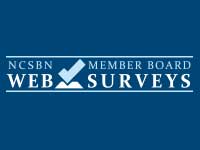
Web Survey Tool
The Web Survey Tool provides members the ability to survey other boards of nursing on topics relevant to their knowledge network.
2018 | Website
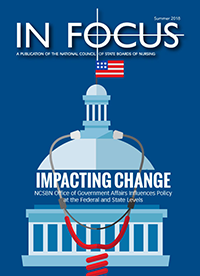
In Focus Summer 2018
- Impacting Change: NCSBN Office of Government Affairs Influences Policy at the Federal and State Levels
- Influencing and Engaging Others: The College of Nurses of Ontario Receives NCSBN’s 2018 Regulatory Achievement Award
- You Do Not Have to Be a Nurse to Be a Leader: Bohn’s Thoughts on Leadership
- Nursys QuickConfirm: the Free and Easy Way to Verify Nurse Authorization to Practice
- NCLEX Practice Exam
2018 | Magazines

Nursys QuickConfirm
Licensure QuickConfirm is a free service that allows employers and recruiters to retrieve licensure and any applicable discipline documentation in one convenient location.
2018 | Video

Nursys e-Notify for Institutions
e-Notify for institutions is an innovative nurse licensure notification system that delivers real-time notifications to employers about nurses in their employ. The system provides licensure and publicly available discipline data directly as the information is entered into the Nursys database by participating nursing regulatory bodies. Learn more about Nursys and nurse license verification.
2018 | Video

NCLEX Examinations Webinar Series: Testing Accommodations
Overview of the accommodations process which will detail the online process, provide insight into NCSBN’s review, and highlight frequently asked questions.
2018 | Recorded Webinar
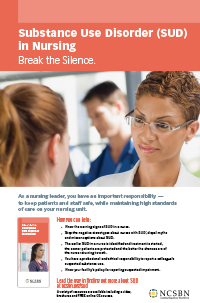
Poster: Substance Use Disorder (SUD) in Nursing: Break the Silence.
This poster is designed to bring awareness about SUD to nursing leaders, as they have an important responsibility — to keep patients and staff safe, while maintaining high standards of care on your nursing unit. This is a companion piece to the brochure A Nurse Manager’s Guide to Substance Use Disorder in Nursing.
2018 | Brochures/Posters
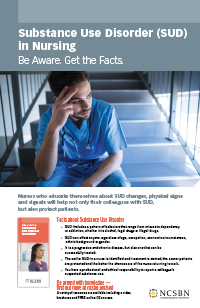
Poster: Substance Use Disorder (SUD) in Nursing: Be Aware. Get the Facts.
This poster is designed to help nurses educate themselves about SUD changes, physical signs and signals will help not only their colleagues with SUD, but also protect patients. This is a companion piece to What You Need to Know About Substance Use Disorder in Nursing.
2018 | Brochures/Posters
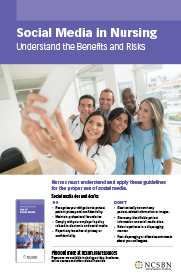
Poster: Social Media in Nursing: Understand the Benefits and the Risks
This poster is designed to help both new and experienced nurses understand how social media can be properly used in the profession without breaking patient privacy and confidentiality laws. This is a companion piece to A Nurse's Guide to the Use of Social Media.
2018 | Brochures/Posters
